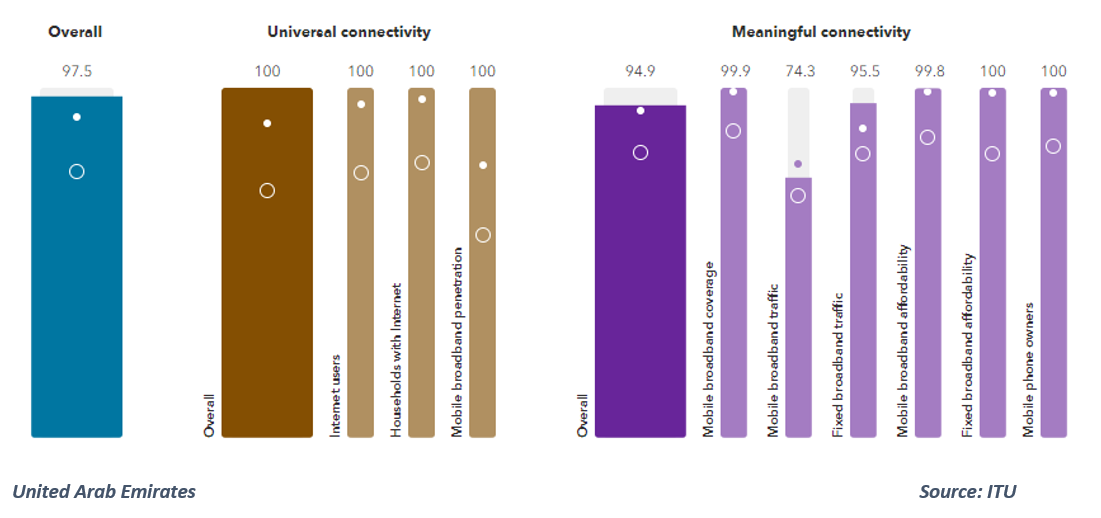The world is making progress towards universal and meaningful connectivity (UMC)—the ability for everyone to go online under optimal conditions, at an affordable cost, anywhere, at any time—according to the 2024 edition of the ITU’s ICT Development Index (IDI).
Leading the Middle Eastern market, the United Arab Emirates scored an overall IDI score of 97.5 (96.4 in 2023) with overall scores of 100 in universal connectivity (UC) and 94.9 in meaningful connectivity (MC), while Saudi Arabia achieved 95.7 (94.9 in 2023) with overall scores of 94.7 in UC and 96.8 in MC.
However, a robust performance in IDI does not necessarily mean that UMC has been achieved as performance could be lacking in other dimensions of UMC that are not currently included in the IDI, such as skills, safety and security.
Related: Telcos Commit USD 9 Billion to ITU’s Call for Universal, Meaningful Connectivity
The UAE ICT market was valued at USD 36.13 billion in 2022 and is set to grow at a CAGR of 12.77% to reach a value of USD 65.90 billion by 2027, according to GlobalData.
Meanwhile, the ICT market in Saudi Arabia was revealed as the largest and fastest growing in the MENA region, with an estimated size of 166 billion riyals.
The Middle East ICT market is expected to reach USD 95.05 billion by 2025, growing from USD 84.23 billion in 2020 at a compound annual growth rate (CAGR) of 2.4%. The IT sector in the Middle East is steadily growing as countries increase their budgets. Since 2008, funding has grown five-fold, and in 2019, amounted to USD 207 billion.
Also Read: ITU Report: Steady But Uneven Progress in Global Internet Connectivity
IDI Scores Breakdown
The average overall score for the 170 economies covered in the new edition of the IDI was 74.8 out of 100, reflecting an improvement of 3.3% from the 2023 edition. Due to the lag in the submission, processing and validation of data by countries, the IDI assessment completed in 2024 reflects the year 2022. Official data from 2021 was also used as the closest reference for gaps in 2022 data.
According to the assessment, more than half of the economies studied were past the 80-point mark. These results suggest that the world is progressing well towards UMC. However, enormous disparities remain evident: the lowest IDI score was 21.3 out of 100, and 29 economies scored below the 50-point mark.
Low-income economies showed the largest improvement; the group’s average IDI score was 36.2, up 13.7% from the previous edition. The largest score increases were mainly driven by gains in internet use, mobile broadband penetration, and affordability. In contrast, high-income economies saw a score increase of only 1.4%, largely due to the fact that their average score was 91.7, leaving little room for improvement. Visit the IDI dashboard to compare all the economies’ scores.
Read More: Lack of Connectivity Stunting Economic Development and Deepening Global Inequalities, Says ITU
Key Highlights
- IDI 2024 Overall Results: The lowest IDI score was 21.3 out of 100, while the highest was 100.0.
- Economic Scores: 42 economies displayed an IDI score between 90 and 100. Another 49 economies displayed a score between 80 and 90, and 41 economies scored between 60 and 80. At the other end of the scale, nine exhibited a score between 50 and 60, and a further 29 economies scored below 50.
- Income Groups: Low-income economies showed the largest average improvement with a 13.7% increase. Lower- to middle-income economies saw a 5.3% increase, upper- to middle-income economies saw a 2.8% increase, and high-income economies saw a 1.4% increase.
- Pillar Scores: Scores on the universal connectivity pillar ranged from 6.7 to 100, with an average of 69.6. The meaningful connectivity pillar scores ranged from 30.6 to 99.9, displaying an average of 80.0.
- Indicators: All ten indicators saw improvements in their average normalized scores from 2023 to 2024. The largest improvement was seen in mobile data and voice affordability, while the smallest was evident in mobile phone ownership.
- Digital Divide: The gap between low-income and high-income economies remains significant. For example, the average IDI score for low-income economies was 36.2, compared to 64.8 for lower- to middle-income economies.
Telecom Review Analysis: The State of Broadband 2024 Report: Assessing How AI is Closing the Digital Gap
The ICT Development Index (IDI) issued by the International Telecommunication Union (ITU) measures digital development and the robustness of the digital infrastructure. The IDI provides comprehensive and transparent data and utilizes methodologies that were co-constructed by member states and teams of experts in the field. However, caution is encouraged when interpreting and using IDI results. Corroboration with additional information and evidence is advised.
Further Coverage: ITU Advances IMT-2030 Development for 6G











